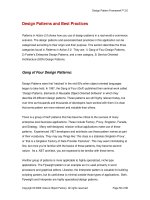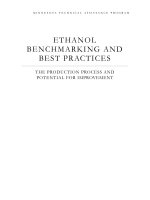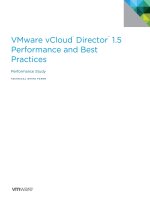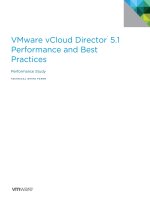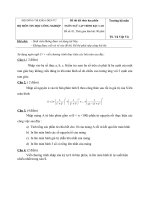backbone js patterns and best practices de 2014 01 24 Lập trình Java
Bạn đang xem bản rút gọn của tài liệu. Xem và tải ngay bản đầy đủ của tài liệu tại đây (1.34 MB, 174 trang )
CuuDuongThanCong.com
/>
Backbone.js Patterns
and Best Practices
A one-stop guide to best practices and design patterns
when building applications using Backbone.js
Swarnendu De
BIRMINGHAM - MUMBAI
CuuDuongThanCong.com
/>
Backbone.js Patterns and Best Practices
Copyright © 2014 Packt Publishing
All rights reserved. No part of this book may be reproduced, stored in a retrieval
system, or transmitted in any form or by any means, without the prior written
permission of the publisher, except in the case of brief quotations embedded in
critical articles or reviews.
Every effort has been made in the preparation of this book to ensure the accuracy
of the information presented. However, the information contained in this book is
sold without warranty, either express or implied. Neither the author, nor Packt
Publishing, and its dealers and distributors will be held liable for any damages
caused or alleged to be caused directly or indirectly by this book.
Packt Publishing has endeavored to provide trademark information about all of the
companies and products mentioned in this book by the appropriate use of capitals.
However, Packt Publishing cannot guarantee the accuracy of this information.
First published: January 2014
Production Reference: 1200114
Published by Packt Publishing Ltd.
Livery Place
35 Livery Street
Birmingham B3 2PB, UK.
ISBN 978-1-78328-357-6
www.packtpub.com
Cover Image by Manali Mandal ()
CuuDuongThanCong.com
/>
Credits
Author
Swarnendu De
Copy Editors
Janbal Dharmaraj
Sayanee Mukherjee
Reviewers
Marc D. Bodley
Florian Bruniaux
Project Coordinator
Sageer Parkar
Philippe Charrière
Ezekiel Chentnik
Lorenzo Pisani
Acquisition Editors
Mary Jasmine Nadar
Gregory Wild
Lead Technical Editor
Ruchita Bhansali
Technical Editors
Vrinda Amberkar Bhosale
Shubhangi H. Dhamgaye
Proofreader
Ameesha Green
Indexer
Hemangini Bari
Graphics
Abhinash Sahu
Production Coordinator
Arvindkumar Gupta
Cover Work
Arvindkumar Gupta
Shweta Pant
Ritika Singh
CuuDuongThanCong.com
/>
About the Author
Swarnendu De is the director of Innofied Solution Pvt. Ltd.
(), a specialized mobile, web, and game development
company. He manages technical operations and leads the JavaScript development
team there. For the last seven years, he has been working with numerous JavaScript
technologies including Backbone.js, Node.js, ExtJS, Sencha, and so on, and has
developed more than 50 complex JavaScript-based applications thus far. He
regularly writes at his personal blog, company blog, and the Tuts+ network.
He has been working with Backbone.js for the last 2 years and has developed
multiple, large, and complex Backbone.js-based applications using this technology.
Swarnendu lives in Kolkata—the city of joy. He loves travelling, photography,
and spending time with his family. You can reach him through his website at
or via Twitter at @swarnendude.
CuuDuongThanCong.com
/>
Acknowledgments
Writing such a book is quite hard, especially when you are busy managing the
operations and technical team at your own startup. I would like to thank my
business partner, Sandip Saha, who shared the workload so that I could spend more
time completing this book. Special thanks to my senior, Saikat Sengupta, who did
all the editing and proofreading for each chapter—the whole journey wouldn't have
been this smooth without his help.
Writing this book would never have been possible without the help of the Backbone
community who have contributed to all the technologies that I have used in this
book. I would like to extend my heartfelt gratitude to the forums, tutorials, and blog
posts for all the discussions, ideas, and feedback that shaped this book. I would
like to thank the technical reviewers who provided immensely useful feedback that
helped me enrich the content of this book. I am very much thankful to Sageer Parkar,
the project coordinator of this book, for his cooperation and assistance.
I want to thank my brother, my closest friends Subhradip, Sudipta, Priyendra,
Suramya, Arup, Payel, and the entire Innofied team for all their support. Finally, a
special thank you to my lovely wife for the moral support and the amazing cover
page photo.
CuuDuongThanCong.com
/>
About the Reviewers
Marc D. Bodley is a passionate user experience engineer and a jack-of-all-trades
developer, with over 8 years experience with JavaScript and frontend technology.
He is excited to see JavaScript being adopted as more of a mainstream development
language and not just an accessory to development. He is equally excited to see the
structure and thought process of more conventional, strongly typed languages being
applied to JavaScript, to bring order to what is potentially a large and disorganized
JS-driven code base. He has worked on large- and small-scale applications for a
range of organizations, from Belk.com to start-up style data-heavy applications. He
continues to look for, learn ,and enforce JavaScript and programming practices, and
was grateful to be a contributor to this effort.
Florian Bruniaux is a French student of the University of Technology of Troyes
(UTT), in the IT and Information Systems department. He is passionate about new
technology, particularly process optimization and software development.
He specializes in frontend and client-side development, and has worked for
various companies such as Aylan (a French startup), Oxylane, and EDF where he
participated in IT projects such as server monitoring systems, cross-browsers, or
multidevice app conception and development.
I would like to thank Steve Burghgraeve, IT engineer at Oxylane,
and Aurélien Bénel, teacher-researcher and lecturer in Computer
Science at UTT, for their help in my different projects and all the
knowledge they've transferred to me.
CuuDuongThanCong.com
/>
Philippe Charrière is a bid manager at Steria in France. At night, he is
an open source developer advocate at Golo project ( />and a Backbone enthusiast. He wrote a small open source book in French about
Backbone.js ( He's also an
occasional speaker on Backbone.js and mobile technologies. He focuses primarily
on open web technologies (front- and server-side).
Ezekiel Chentnik has over 8 years experience in frontend engineering and
JavaScript development. He is a JavaScript whiz kid and whatever the challenge is,
he takes it. He is passionate about his work and is constantly pushing the limit.
His recent projects include some of his favorite JavaScript libraries: Zepto.js,
Backbone.js, Underscore.js, Marionette.js, and Modernizr.js. Learn more about
Ezekiel at .
Lorenzo Pisani is a software engineer with over a decade of experience developing
applications with PHP, MySQL, and JavaScript. As a huge advocate of open source
software, he publishes just about everything he builds outside of work to his GitHub
profile ( for others to use and learn from.
CuuDuongThanCong.com
/>
www.PacktPub.com
Support files, eBooks, discount offers and more
You might want to visit www.PacktPub.com for support files and downloads related
to your book.
Did you know that Packt offers eBook versions of every book published,
with PDF and ePub files available? You can upgrade to the eBook version at
www.PacktPub.com and as a print book customer, you are entitled to a discount on
the eBook copy. Get in touch with us at for more details.
At www.PacktPub.com, you can also read a collection of free technical articles, sign
up for a range of free newsletters and receive exclusive discounts and offers on Packt
books and eBooks.
TM
Do you need instant solutions to your IT questions? PacktLib is Packt's online
digital book library. Here, you can access, read and search across Packt's entire
library of books.
Why Subscribe?
• Fully searchable across every book published by Packt
• Copy and paste, print and bookmark content
• On demand and accessible via web browser
Free Access for Packt account holders
If you have an account with Packt at www.PacktPub.com, you can use this to access
PacktLib today and view nine entirely free books. Simply use your login credentials
for immediate access.
CuuDuongThanCong.com
/>
CuuDuongThanCong.com
/>
CuuDuongThanCong.com
/>
Dedicated to my parents.
All the good that happened in my life happened because of your example,
guidance, and love!
CuuDuongThanCong.com
/>
CuuDuongThanCong.com
/>
Table of Contents
Preface1
Chapter 1: Reducing Boilerplate with Plugin Development
7
Basic components of Backbone.js
Using Underscore.js
Re-using code with extensions
Creating a base class
Developing plugins without extending base classes
Understanding JavaScript mixins
What is a mixin?
Creating classic mixins
Creating functional mixins
9
10
11
12
14
15
16
16
17
Summary
21
Caching mixin functions
Using curry to combine a function and arguments
Chapter 2: Working with Views
23
Basic usage of views
Understanding the el property
Listening to view events
Displaying model data with templates
Partially updating a view
Understanding nested views
Knowing when to use subviews
Avoiding multiple DOM reflow
Re-rendering parent views
Removing parent views
Working with templates
Storing templates in an HTML file
Storing templates in a JavaScript file
CuuDuongThanCong.com
18
19
24
25
26
27
28
29
32
33
34
35
37
37
38
/>
Table of Contents
Precompiling templates
39
Avoiding evaluation in templates
40
Using template helper functions
41
Understanding automatic model-view data binding
42
Using Marionette's ItemView, CollectionView, and CompositeView
43
ItemView43
CollectionView45
Working with CompositeView
46
Using Layout Manager
50
Summary
56
Chapter 3: Working with Models
57
Basic usage of models
Using the defaults property
58
59
Avoiding object references in the defaults property
59
Data interaction with the server
Validating the data
Using the Backbone.Validation plugin
60
62
64
Serializing models
Understanding the relational data model
Summary
66
69
72
Configuring validation rules
Prevalidating a model with the preValidate() method
64
66
Chapter 4: Working with Collections
73
Basic usage of collections
Performing data operations with collections
74
75
Fetching data from the server
Saving data to the server
75
75
Sorting a collection
76
Filtering a collection
Performing basic filtering
Filtering a collection with a duplicate collection
Self-filtering with full data pointers
Understanding the collection of multiple model types
Summary
78
78
79
80
82
83
Sorting a collection with multiple attributes
Chapter 5: Routing Best Practices and Subrouting
Working with routers
Best practices for working with routers
Avoiding large functional code in route methods
Instantiating views in router methods
Using regular expressions for selective routing
[ ii ]
CuuDuongThanCong.com
/>
77
85
86
87
87
88
89
Table of Contents
Subrouting – a key to organizing complex apps
Summary
Chapter 6: Working with Events, Sync, and Storage
Understanding custom events
A simple case study on custom events
Using an event dispatcher
Creating multiple event dispatchers
Using different event namespaces
Avoiding memory leaks with the listenTo() method
Overriding the Backbone.sync() method
Offline storage using the Backbone.LocalStorage adapter
Summary
Chapter 7: Organizing Backbone Applications – Structure,
Optimize, and Deploy
Understanding the application directory structure
Working with Asynchronous Module Definition
Adding Require.js to your project
Configuring dependencies
Defining a module
Creating application architecture
Managing a project directory
Organizing code with AMD
Setting up an application
Using the module pattern
Managing objects and module communication
Understanding view management
Understanding other important features
Summary
Chapter 8: Unit Test, Stub, Spy, and Mock Your App
Understanding why unit testing is important
Testing with QUnit
Performing a basic test case
Understanding the QUnit module (), setup (), and teardown () methods
Testing Backbone.js components with QUnit
Using test spies, stubs, and mocks with SinonJS
Testing with spies
Testing with stubs
Testing with mocks
Difference between mocks and stubs
Summary
95
96
97
98
99
100
100
102
104
105
107
108
110
111
111
112
114
114
115
115
116
118
122
123
124
125
126
126
128
129
129
130
131
132
134
135
136
[ iii ]
CuuDuongThanCong.com
90
93
/>
Table of Contents
Appendix A: Books, Tutorials, and References
137
Appendix B: Precompiling Templates on the Server Side
Appendix C: Organizing Templates with AMD and Require.js
141
145
Index
149
Books for reference
Tutorials
Unit testing
Other plugins and tutorials
137
138
138
139
Precompiling with the requirejs-tpl plugin
[ iv ]
CuuDuongThanCong.com
/>
146
Preface
Though Backbone.js provides a structure for JavaScript applications, developers
need to take care of most of the design patterns and best practices themselves. Over
the years, my JavaScript development team and I worked on multiple Backbone.js
applications ranging from simple to extremely complex. We experienced different
types of problems related to layout management, project architecture, modular
development, and so on. Before I started writing this book, I spent a significant
amount of time trying to figure out solutions for all the common problems associated
with the development of Backbone.js applications. In this book, I have documented
all my findings in detail.
Whether you are an intermediate- or advanced-level Backbone.js developer, this
book will guide you through the best practices and patterns to handle different
issues with each Backbone component. Whether this is by using your own solution
or an existing Backbone plugin, you will get a clear idea of the best way to resolve
any problem.
Instead of developing a single application spanning all the chapters, a simple and
complete example on each topic is provided separately throughout this book. This
is because it would be quite difficult to implement all the tips and patterns given in
this book in a single application. Moreover, we preferred to provide immediate and
compact solutions to problems, instead of including all the problems and solutions
in a single large application. Within a short span, this book tries to cover all the
important points you may need for the development of your Backbone.js application.
CuuDuongThanCong.com
/>
Preface
What this book covers
Chapter 1, Reducing Boilerplate with Plugin Development, starts with the basics of why
reusing your code is important, and how we can achieve that by creating custom
Backbone.js widgets and mixins.
Chapter 2, Working with Views, discusses the different points related to view rendering
and layout management. Starting from partial updating of views, functionality of
nested views or subviews for different processes of JavaScript template management
and best practices, this chapter covers most of the problems a developer may face
while working with views. We conclude by writing about the Marionette custom
views and the Layout Manager plugin for complex app layout management.
Chapter 3, Working with Models, talks about different patterns while working with
Backbone models, including data validation, model serialization to fetch data, and
saving data to the server. We also analyze the relational data model for one-to-many
and many-to-many relationships using Backbone's relational plugin.
Chapter 4, Working with Collections, covers a number of common problems that
developers face while using Backbone collections. We explain how to apply basic
and multiple sorting, how to apply filtering to a collection, and how to manage a
collection while a mixed set of data is passed from the server.
Chapter 5, Routing Best Practices and Subrouting, covers a number of best practices
you should follow while working with routers. We also discuss the benefits of using
multiple routers or subrouters for complex and large-level applications.
Chapter 6, Working with Events, Sync, and Storage, begins by describing the
importance of custom events to enhance an application's modularity and reusability.
We also discuss using an application-level event manager to work as a centralized
PubSub system, and the use of the Backbone.sync() method to create different
data-persistent strategies.
Chapter 7, Organizing Backbone Applications – Structure, Optimize, and Deploy, is
one of the most important chapters that a developer will find very useful if they
are developing a complex Backbone application. It talks about the application
directory structure, organizing and managing files with RequireJS, and the different
architectural patterns that every JavaScript developer should follow to develop
large-scale application architectures.
Chapter 8, Unit Test, Stub, Spy, and Mock Your App, talks about the benefits of unit
testing your JavaScript application, and introduces you to the QUnit and SinonJS test
frameworks.
[2]
CuuDuongThanCong.com
/>
Preface
Appendix A, Books, Tutorials, and References, lists a number of useful Backbone.js
resources that you may find helpful.
Appendix B, Precompiling Templates on the Server Side, describes the benefits of
precompiling JavaScript templates at server side with examples.
Appendix C, Organizing Templates with AMD and Require.js, discusses the process of
storing and organizing JavaScript templates with the RequireJS, text!, and tpl! plugins.
What you need for this book
Most of the code in this book can be opened in a simple text editor (Notepad++
or Sublime Text). To run the code, you can use any web browser. For some code,
you may need a local server (Apache or IIS) to be set up. For Node.js-related
functionality, you need to set up a Node.js server.
Who this book is for
This book is for any developers who has a basic knowledge of Backbone.js and
is looking for solutions to common Backbone.js problems, looking to enforce
reusability in their code by removing boilerplate and developing custom plugins and
extensions, and hoping to use the most effective patterns to develop large-scale web
application architecture.
This book is not a general introduction to Backbone.js or JavaScript design patterns.
There are lots of books, tutorials, and screencasts available that cover a general
introduction in great detail. While this book will discuss the basics of the Backbone.js
components in each chapter, the main priority will be to provide you with the concepts
of developing a robust, high quality, and flexible code base.
Conventions
In this book, you will find a number of styles of text that distinguish between
different kinds of information. Here are some examples of these styles, and an
explanation of their meaning.
Code words in text, database table names, folder names, filenames, file extensions,
pathnames, dummy URLs, user input, and Twitter handles are shown as follows:
"We can include other contexts through the use of the include directive."
[3]
CuuDuongThanCong.com
/>
Preface
A block of code is set as follows:
var MainView = Backbone.View.extend({
el : '#main',
render : function(){
this.$el.html(new BaseView().render().el);
}
});
When we wish to draw your attention to a particular part of a code block, the
relevant lines or items are set in bold:
var BaseView = Backbone.View.extend({
template : '
<%= name %>
',render : function(){
var html = _.template(this.template, {
name : 'Swarnendu De'
});
this.$el.html(html);
return this;
}
});
New terms and important words are shown in bold. Words that you see on
the screen, for example, in menus or dialog boxes appear in the text like this:
"clicking on the Next button moves you to the next screen".
Warnings or important notes appear in a box like this.
Tips and tricks appear like this.
[4]
CuuDuongThanCong.com
/>
Preface
Reader feedback
Feedback from our readers is always welcome. Let us know what you think about
this book—what you liked or may have disliked. Reader feedback is important for us
to develop titles that you really get the most out of.
To send us general feedback, simply send an e-mail to ,
and mention the book title via the subject of your message.
If there is a topic that you have expertise in and you are interested in either writing
or contributing to a book, see our author guide on www.packtpub.com/authors.
Customer support
Now that you are the proud owner of a Packt book, we have a number of things to
help you to get the most from your purchase.
Downloading the example code
You can download the example code files for all Packt books you have purchased
from your account at . If you purchased this book
elsewhere, you can visit and register to
have the files e-mailed directly to you.
Errata
Although we have taken every care to ensure the accuracy of our content, mistakes
do happen. If you find a mistake in one of our books—maybe a mistake in the text or
the code—we would be grateful if you would report this to us. By doing so, you can
save other readers from frustration and help us improve subsequent versions of this
book. If you find any errata, please report them by visiting ktpub.
com/submit-errata, selecting your book, clicking on the errata submission form link,
and entering the details of your errata. Once your errata are verified, your submission
will be accepted and the errata will be uploaded on our website, or added to any list of
existing errata, under the Errata section of that title. Any existing errata can be viewed
by selecting your title from />
[5]
CuuDuongThanCong.com
/>
Preface
Piracy
Piracy of copyright material on the Internet is an ongoing problem across all media.
At Packt, we take the protection of our copyright and licenses very seriously. If you
come across any illegal copies of our works, in any form, on the Internet, please
provide us with the location address or website name immediately so that we can
pursue a remedy.
Please contact us at with a link to the suspected
pirated material.
We appreciate your help in protecting our authors, and our ability to bring you
valuable content.
Questions
You can contact us at if you are having a problem with
any aspect of the book, and we will do our best to address it.
[6]
CuuDuongThanCong.com
/>
Reducing Boilerplate with
Plugin Development
"When working on a web application that involves a lot of JavaScript, one of the
first things you learn is to stop tying your data to the DOM. It's all too easy to
create JavaScript applications that end up as tangled piles of jQuery selectors and
callbacks, all trying frantically to keep data in sync between the HTML UI, your
JavaScript logic, and the database on your server. For rich client-side applications,
a more structured approach is often helpful."
The previous excerpt from precisely specifies the problem
that Backbone.js solves. Backbone.js provides a way to simplify the JavaScript
application structure, which was clearly a nightmare, even a few years ago. Today,
we have moved a long way from tightly coupled jQuery-based applications to
heavy frontend applications, and a major portion of the application logic now relies
on the UI part. This means organizing the application structure is now one of the
most significant aspects of application development, and should take care of the
reusability, modularity, and testability of the components of an application.
Being an extremely lightweight library, Backbone.js, along with the utility library
Underscore.js, provides a set of tools that help to organize your code and makes it
easier to develop single-page web applications. Backbone delivers a minimalistic
solution to separate the concerns of your application; features include RESTful
operations, persistent strategies, models, views with logic, event-driven component
communication, templating, and routing facilities. Its simplistic nature, excellent
documentation, and a large community of developers make it easy to learn how to
use this library.
CuuDuongThanCong.com
/>
Reducing Boilerplate with Plugin Development
However, to develop a robust system, we do not depend only on the basic functional
components of the framework; we have to use many other libraries, plugins, and
reusable add-ons to support the core system as well. While Backbone.js with its core
components provides a way to structure your application at the base level, it is really
not enough until we either develop our own or use other open source extensions,
plugins, and useful patterns. In order to create solid, software architecture, we need
to make the best use of existing components and follow proper design patterns. This
is what we intend to deliver in this book.
This is not a general introduction book, and we expect our readers to have a basic
understanding of the Backbone.js framework. If you are a beginner and looking
for good resources to start with Backbone.js, we will recommend you to refer
Appendix A, Books, Tutorials, and References, of this book, where we listed a number
of useful resources to help you master Backbone.js.
We will start with an understanding of how we can re-use our code and reduce
a boilerplate by developing custom extensions, plugins, and mixins. In the latter
chapters, we will start discussing the common problems, tips, patterns, best practices,
and open source plugins for each Backbone.js component. We will also see how
we can use Backbone.js to structure and architect complex web applications, and
understand the basics of unit testing in JavaScript-based applications. In addition,
instead of developing a single application spanning all the chapters, we have tried to
provide simple and complete examples on each topic separately throughout this book.
In this chapter, we will learn a few important topics with examples. These topics and
concepts will be used many times in rest of the chapters. They are as follows:
• Basic components of Backbone.js: This consists of a brief discussion about
the definitions of the Backbone components
• Use of Underscore.js: This consists of a brief discussion about Underscore.js
and the utility of using this library for JavaScript-based projects
• Re-use code with extensions: This consists of reusing the Backbone code by
moving common code blocks to parent-level classes
• Backbone mixins: This consists of an explanation of what mixin is, and how
and where to use mixins with Backbone
[8]
CuuDuongThanCong.com
/>
